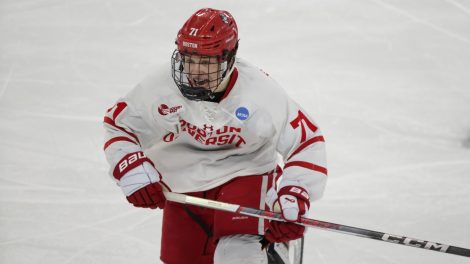We used to think we had this hockey thing pretty much figured out.
Not completely, of course — it’s not like there was one standard path to winning a Stanley Cup, and anyone who followed it was guaranteed a championship. Hardest trophy to win in all of sports, we used to say. Anything can happen in the NHL, and all that.
But as the salary-cap era rolled into its second decade, the hockey world had compiled a decent batch of conventional wisdom. The road to building a champion was still a difficult one, but there were certain guideposts we could count on along the way. After watching 30 teams try to win a title every year, we felt like we had a pretty good idea about what worked and what didn’t.
And then the Vegas Golden Knights came along and made us all look like fools.
As the Knights get ready to play for the Stanley Cup, much of the attention has been on the big-picture stuff we all got wrong. The Las Vegas market wouldn’t work. The roster would be terrible. Expansion teams have to be terrible in year one. Wrong, wrong, wrong.
That stuff matters. But at the end of the day, whichever way this year’s final turns out, the big-picture stuff can’t teach us all that much. We’ll ratchet up expectations for Seattle, sure, but that’s about it. The far more interesting question is what kind of smaller lessons we can learn from the Golden Knights. And more specifically, which of our precious nuggets of accepted conventional wisdom may have just been proven wrong?
That’s the sort of stuff that, if it sticks, could change how NHL teams around the league make decisions. So today, let’s run through six lessons we can learn from this Vegas miracle, and how they could influence the way rosters are built in the future.
What we thought we knew: A few bad contracts are just the cost of doing business
Just about every team has them. Scroll through the rosters on a site like Cap Friendly, and you’ll find almost all of them cluttered with bad contracts, buyouts, retained salary and long-forgotten veterans stashed away on the LTIR. Add it all up, and virtually every team is starting the season with a big chunk of their payroll and their cap space dedicated to dead money.
Some of those contracts were just mistakes, where a team gambled and lost. That’s unavoidable in a cap league. But plenty of them were predictable cases of a team taking on a deal that they knew would almost certainly go bad. At some point, every NHL team apparently decided that short-term gain meant long-term pain, and every well-built roster could afford to kick the can down the road on at least a few mistakes.
If you think a player has three good years left, you have to give him five. If he has five good years left, you give him eight. The approach kept the cap hit down, and you could always consider buyouts or LTIR shenanigans down the line. And hey, if things went really bad, the player would end up being the next GM’s problem.
What the Golden Knights taught us: When people write the “How did we get here?” stories about the Golden Knights, most of the focus lands on the expansion-draft picks and the trades that surrounded them. And rightly so — that’s where most of the big mistakes happened. But we’re overlooking one of the greatest assets the Knights started with: A crystal-clear cap situation.
No long-term commitments. No mistakes. No dead money. And no guys on the wrong side of 30 who still had five years left on a contract that was paying them based on what they did at 25.
If you don’t think that’s important, look at how many of the expansion-draft trades the Knights pulled off were based around another team desperately trying to get out of a bad deal. Without David Clarkson, the Blue Jackets may not lose William Karlsson. Without Reilly Smith, the Panthers don’t have to part with Jonathan Audy-Marchessault. The Islanders coughed up a first and more to get rid of Mikhail Grabovski.
On the day they were born, the Knights were the only team in the league without any cap mistakes. They have some now, but it’s by choice, and they were paid a premium to take them on. And once they’re done winning the Stanley Cup, they’ll still head into the off-season with a ton of cap space to work with.
What the other 30 teams can learn: A contract that seems good for the first few years but is likely to go bad down the road is not a good contract. Sure, keeping the term reasonable might jack up the cap hit, or even cost you a chance at certain players. But maybe it’s not enough to sign a deal you know will turn into an albatross, then shrug and say “Everyone does it.” We’ve just seen what a smart team can do when a cap sheet that isn’t cluttered up with foreseeable mistakes.
[snippet id=3816507]
What we thought we knew: You win with elite talent
Depth matters. Character matters. Coaching matters. Having the right guys in the right roles who understand what they need to do matters. But as parity and the salary cap work relentlessly to flatten the talent gap between teams, the NHL is becoming a league where elite talent makes the difference. Compare any two random teams, and chances are that 80 percent of the rosters will be largely interchangeable. But the elite talents — the Crosbys and McDavids and Doughtys and Kucherovs — are the ones that make the difference between contending and pretending.
And we all know it. That’s why we see so many teams tank in hopes of landing a top draft pick. Giving up an entire season just to increase your lottery odds seems like a bad tradeoff. But when those top picks are your best shot at acquiring the sort of elite talent that wins championships, you bite the bullet and do what you have to do.
What the Golden Knights taught us: You can win without anything approaching elite talent, as long as you have the right mix.
Marchessault is a very good player, but he’s nowhere near the Crosby tier. Neither is William Karlsson, even coming off a career year. Marc-Andre Fleury has been fantastic in the playoffs, and goaltending is a bit of a different case, but he hasn’t received a Vezina vote since 2012. And nobody else on the roster is really even in the elite-talent discussion. And yet, here they are.
What the other 30 teams can learn: Maybe tanking isn’t the answer. Then again, a lot of us wondered if the Knights were tanking heading into this season, and look how that turned out. But at the very least, the idea that you do whatever it takes to get players who are (or will be) in the elite tier and worry about the rest of the roster later may be worth a second look.
[snippet id=3918715]
What we thought we knew: This is now a draft-and-develop league
It has to be. The salary cap has neutered free agency. And as we’re constantly reminded, it’s made trading way too hard. So that leaves the patient approach – draft well, develop those players, and then hope for a payoff that may take years to arrive. You can’t rush it.
What the Golden Knights taught us: Apparently you can rush it.
The Knights are obviously a special case, and we won’t push this point too far. We’ll just state the facts: Vegas made more off-season trades last year than any other team, and they’re about to become the first team in decades to play for the Stanley Cup without a single homegrown entry-draft pick on the roster. Sure, they had no choice in the matter. But McPhee built a championship-caliber roster in year one, and he did it largely using tools that aren’t supposed to work anymore.
What the other 30 teams can learn: Draft-and-develop is still a viable strategy that can pay off when done right — the Winnipeg Jets are proof of that. But it’s not the only way, no matter what your GM and his five-year plan try to tell you.
[snippet ID=3322139]
What we thought we knew: It doesn’t take all that long to figure out what a player can be
By the time a player is drafted, we already have years of scouting reports to go on. Most guys get a few years in the minors after that. Once a player makes the NHL, there’s usually a fairly well-established consensus on what their role should look like, and how good they can be.
Everyone deserves an opportunity to prove the doubters wrong, and occasionally injuries or unforeseen circumstances will give a guy a chance to move higher in the lineup and show what they can do. But generally, you don’t need to see all that much of a player at the NHL level to know what you have.
What the Golden Knights taught us: There may be more diamonds in the rough than we thought.
The Golden Knights’ success basically boils down to a whole bunch of guys being given more opportunity than they’d ever had before, and almost all of them exceeding expectations. Karlsson is the obvious outlier, going from depth forward to 43-goal sniper almost overnight. But the roster is filled with similar cases, from veterans like David Perron to less-experienced players like Erik Haula.
What the other 30 teams can learn: It might be worth revisiting some assumptions about the players you have, especially the ones further down the lineup. Justin Bourne said it best:
As a tactical matter, that might also mean avoiding the temptation to throw money (and term) at veteran free agents to fill out holes in the roster during the off-season. Sure, it’s tempting to solve a problem by signing an older player that you know can give you reliable C+ minutes. But maybe you’ve got something better already in the organization. It might be worth it to find out.
What we thought we knew: You can’t win the Cup without a stud defenceman
This one’s been around for years, and it makes sense. Go down the list of Cup winners and count the Norris candidates. Lidstrom, Niedermayer, Chara, Letang, Keith, Doughty… virtually every champion of the last few decades has a stud anchoring the blue line.
What the Golden Knights taught us: This one already lost some luster last season, when Letang missed the playoffs and the Penguins still won it all with a patchwork defence corps. But seeing the Knights go all the way with a blue line headlined by Colin Miller, Shea Theodore and Nate Schmidt might finish it off for good. Those are good players, and some of them might even get a Norris vote or two someday. But there isn’t a Victor Hedman, P.K. Subban or Brent Burns in the bunch, or even anything close.
What the other 30 teams can learn: Obviously, every team should still want an elite defenceman; they should want as many as possible. But the idea that it’s an absolute must-have for any team that wants to win a Cup is worth revisiting. That could have an impact on the off-season strategy of teams like Toronto and Edmonton, and maybe also the asking price for names like Erik Karlsson or Dougie Hamilton.
[snippet id=3317857]
What we thought we knew: Being boring wins
This will be a tough one to challenge, since there’s over 20 years of hockey wisdom behind it. And as a fan, you’ve heard it all before. It’s a 3–2 league. Defence wins championships. No coach is ever happy after a 6–5 win. Better to block shots, take away lanes, make the safe plays, and avoid mistakes. A 1–0 win might not be exciting, but it’s a win.
Besides, offence is hard to find. You can score a lot of goals if you’re the Penguins or Lightning and you’re loaded with future Hall of Famers. But for everyone else, it’s better to slow it down and play it safe.
What the Golden Knights taught us: With the right game plan and a coach who trusts them, a bunch of castoffs can light up the league.
That’s maybe the most amazing thing about this Golden Knights’ season. Whenever expansion teams have had any success in the past, it’s been by clutching and grabbing and trapping and basically boring everyone half to death.
Not Vegas. They drafted as much speed and skill as they could find, then turned it loose on the league. And they ended up tied with those loaded Penguins for fourth in goals scored.
What the other 30 teams can learn: Coaches might want to rethink their defence-first philosophies, although that’s probably a big ask from guys who’ve never known any other way. GMs might rethink their roster construction, and the value of pushing their coaches to play an attacking style that may be outside their comfort zone.
But the real lesson here could be for the NHL’s owners — especially the ones struggling to fill their buildings. For years, your GMs and coaches have told you that they have to play a stifling defensive system, because it’s the only way to win. Then along comes an expansion team, and they instantly become one of the most entertaining teams in the entire league. Oh, and they win. And the building is full. And their fans are hooked.
Meanwhile, you’re trying to sell tickets to watch guys chip pucks off the glass and out. Is it really impossible to believe that your product could be at least as much fun as an expansion team’s? Are you sure? Maybe the next time the people you’re paying big bucks to run your team tell you that boring is the only way to go, it might be worth pushing back just a little. Or finding new people.









